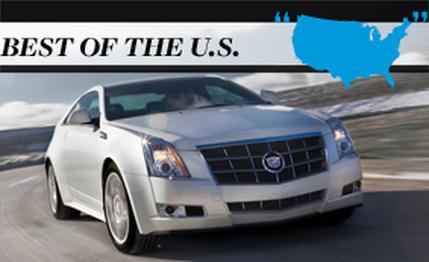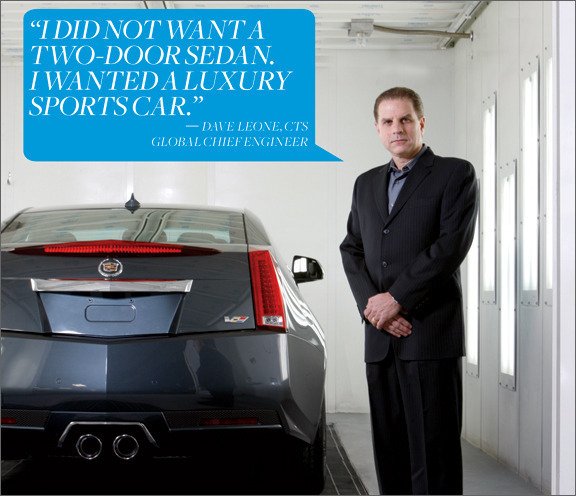
 Prototype Drive
Prototype Drive




Disregarding the tony black slacks he’s wearing and the wet garage floor, Dave Leone is on his knees. “Look at this,” he says, shoving his hand between the top of a Cadillac CTS Coupe’s rear tire and the upper fender lip. “I call this the ‘Leone Finger Test.’ If three fingers fit, the gap’s too big. What I got here is two and three-quarters, max.”
He’s not done yet.
Leone next positions a ruler flat against the side of the flared rear fender and flat against the tire’s sidewall. “See that?” he asks, beaming. The ruler is perfectly vertical. “The wells on this car are completely filled, and the wheels line up flush with the body. Makes it look squat, purposeful. If you’ve got wheels just floatin’ around in there, well, to me that looks like a fat lady on skates.”
Leone has spent 30 of his 52 years toiling exclusively for Cadillac. He is the global chief engineer for the CTS—the sedan, the wagon, and now the coupe, arguably one of the most striking GM cars ever to choke its wheel wells.
Every panel from the base of the coupe’s A-pillars forward is identical to the CTS sedan’s. Every panel aft of the A-pillars is unique. “We had zero interest in creating a CTS sedan minus two doors,” Leone says. He lovingly sweeps a hand over the windshield and roof. “The front glass is laid back an extra two degrees,” he notes, “and the roof is two inches lower, blending back into this radically raked backlight. We really hunkered her down.” So much, in fact, that the seats had to be mounted 14 millimeters lower than the sedan’s.
But Leone’s proudest achievement may be those flared rear fenders—“tautly swollen,” he says of them—which were made possible only by widening the coupe’s rear track by two inches. Consequences ensued.
To get the stance he longed for, Leone had to persuade GM to bless the coupe with more rubber at the rear than at the front. The FE3 suspension on the V-6 coupe, for instance, features 245/45R-19s up front, 275/40R-19s at the tail. But then the handling didn’t suit Leone, so rack after rack of experiÂmenÂtal anti-roll bars were trotted out. Coincidentally, both the CTS Coupe and the CTS-V Coupe felt most neutral with a 29mm front bar (versus the sedan’s 31) and a 25.4mm rear bar (versus the regular sedan’s 20 and the V’s 24). Leone then firmed up the damping at all four corners, obtaining, he says, “0.88 g [of grip] for the V-6 car and 0.9-something for the CTS-V.” He jacked up the final-drive ratio to 3.73:1 from 3.42:1 for most models, dialed out every remaining iota of on-center steering slop, then blasted ’round the “Lutz Ring” (GM’s road course at its proving ground in Milford, Michigan), pronouncing both coupes “more planted, easier to place, harder to disrupt, and sharper on turn-in.”
“I did not want a two-door sedan,” he repeats. “I wanted a luxury sports car.”
The CTS Coupe will be fitted with only the 304-hp, 3.6-liter V-6, familiar as the Camaro’s base powerplant. The CTS-V will inherit its forebear’s drivetrain verbatim, notably the thunderous 556-hp, 6.2-liter V-8. Leone expects the V to wreak havoc on several Euro all-stars, notably the Audi S5, the BMW M3, the Jaguar XKR, and the forthcoming Mercedes-Benz E63 coupe.
Curiously, the CTS Coupe’s center-mounted rear stop light is shaped like a decklid spoiler, but the CTS-V’s blatantly pokes skyward an inch higher, generating extra downforce. Both coupes will be offered with six-speed automatics or six-speed manuals, “although I think we sold about 200 manuals last year,” Leone confesses. All-wheel drive is available on the V-6 car—a 200-pound penalty—while the CTS-V adheres to rear-drive only.


Neither coupe emerged as svelte as Leone had hoped. The entry-level car, at just less than two tons, is only 22 pounds lighter than its sedan counterpart. The CTS-V is 37 pounds slimmer. Approaching from behind, you can differentiate the two by their chrome exhaust tips: centrally mounted twin trapezoids for the V-6 and virtual sewer pipes for the CTS-V—twin cannons almost 4.5 inches in diameter. The coupes are devoid of any exterior locks, door handles, or trunk handles, opting for automatic touch-pad openers, Ã la Corvette’s. Speaking of the trunk, it’s small: 11 cubic feet versus the sedan’s 14.
The CTS-V we examined wasn’t yet roadworthy, but we were granted a brief drive in a preproduction V-6 with the FE3 suspension. We reserve the right to alter our opinions, but we can report with confidence that the coupe is even more gratifying and engaging than the sedan. The steering’s on-center feel is superb, with zero kickback and a sense of straight ahead that is peerless. The brake pedal is quite firm but easy to modulate. The damping is clearly tighter—big displacements induce one compression and one rebound, no encores—but if ride quality has degraded, we didn’t notice it. Even at 80 mph, the cockpit remains hushed, marred only by a slight whooshing of air over the A-pillars. Step-off is predictable, and the V-6 feels certain to knock out sub-six-second sprints to 60 mph, doing so with an exhaust note that very nearly mimics a V-8’s.
The fat C-pillars, the dagger-like rear side windows, and the towering bustle obscure sightlines astern, but at least front passengers suffer no sense of claustrophobia. The same cannot be said of rear-seat riders. Volume behind the front seats is 36 cubic feet versus the sedan’s 42. There’s plenty of kneeroom back there, but the sloping roof rudely rubbed the balding pate of your five-foot-nine-inch author. Note also that there are only two rear buckets. “We never intended this to be a five-passenger anything,” Leone asserts. At least gymnastics aren’t necessary to fold yourself within, thanks to the vast doors, each an alarming 58.5 inches long.
What the CTS Coupe feels like is a more focused CTS sedan—more willing in every direction, more telepathic, a titch more in sync with the driver’s commands. And once you’ve parked the coupe, you find yourself dreamily gazing at it—especially the tail—for an extra beat or two.
When you amble into showrooms in June, expect something like a $3000 premium over the sedan. If you’re holding out for a convertible, don’t. “From day one,” asserts Leone, “I knew the extra mass we’d need to create a solid roofless platform was more than I could abide.” The marketing guys predict that less than 20 percent of all CTS buyers will be couped up.
It’s astonishing, really, that such a stunning, conscientiously rendered automobile could have emerged against a backdrop of fiscal earthquakes, massacre-quality layoffs, and—at last count—three CEOs. Advice to Mr. Whitacre: Hang around long enough to claim this one as your own.

